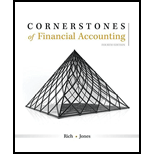
Concept explainers
Exercise 4-54 Operating Cycle and Current Receivables
a. Dither and Sly are attorneys-at-law who specialize in federal income tax law. The): complete their typical case in 6 months or less and collect from the typical client within 1 additional month.
b. Johnston’s Market specializes in fresh meat and fish. All merchandise must be sold within one week of purchase. Almost all sales are for cash and any receivables are generally paid by the end of the following month.
c. Mortondo’s is a women’s clothing store specializing in high-style merchandise. Merchandise spends an average of 7 months on the rack following purchase. Most sales are on credit and the typical customer pays within 1 month of sale.
d. Trees Inc. grows Christmas trees and sells them to various Christmas tree lots. Most sales are for cash. It takes 6 years to grow a tree.
Required:
For each of the businesses described above, indicate the length of the operating cycle.
Want to see the full answer?
Check out a sample textbook solution
Chapter 4 Solutions
Cornerstones of Financial Accounting
- The Flapjack Corporation had 8,350 actual direct labor hours at an actual rate of $14.50 per hour. Original production had been budgeted for 1,300 units, but only 1,200 units were actually produced. Labor standards were 8.3 hours per completed unit at a standard rate of $16.00 per hour. Compute the direct labor cost variance.arrow_forwardGive me this question solutionarrow_forwardCan you please solve this questionsarrow_forward
 Intermediate Financial Management (MindTap Course...FinanceISBN:9781337395083Author:Eugene F. Brigham, Phillip R. DavesPublisher:Cengage Learning
Intermediate Financial Management (MindTap Course...FinanceISBN:9781337395083Author:Eugene F. Brigham, Phillip R. DavesPublisher:Cengage Learning College Accounting, Chapters 1-27AccountingISBN:9781337794756Author:HEINTZ, James A.Publisher:Cengage Learning,
College Accounting, Chapters 1-27AccountingISBN:9781337794756Author:HEINTZ, James A.Publisher:Cengage Learning, PFIN (with PFIN Online, 1 term (6 months) Printed...FinanceISBN:9781337117005Author:Randall Billingsley, Lawrence J. Gitman, Michael D. JoehnkPublisher:Cengage Learning
PFIN (with PFIN Online, 1 term (6 months) Printed...FinanceISBN:9781337117005Author:Randall Billingsley, Lawrence J. Gitman, Michael D. JoehnkPublisher:Cengage Learning- Principles of Accounting Volume 1AccountingISBN:9781947172685Author:OpenStaxPublisher:OpenStax College
 Cornerstones of Cost Management (Cornerstones Ser...AccountingISBN:9781305970663Author:Don R. Hansen, Maryanne M. MowenPublisher:Cengage Learning
Cornerstones of Cost Management (Cornerstones Ser...AccountingISBN:9781305970663Author:Don R. Hansen, Maryanne M. MowenPublisher:Cengage Learning




